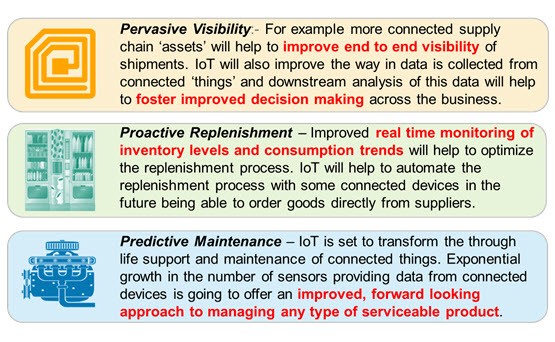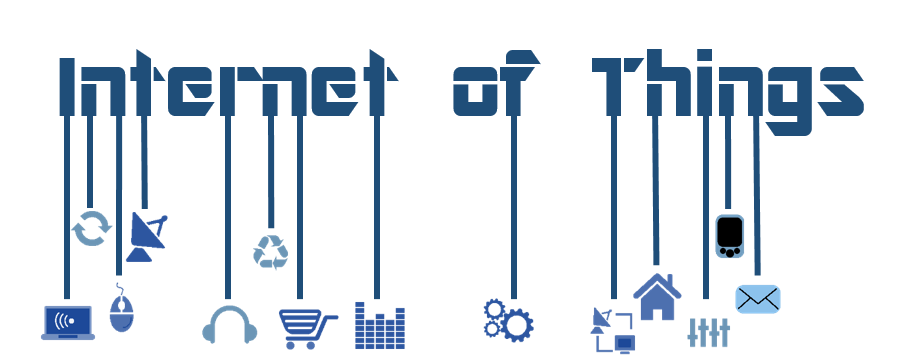There is a lot of talk about the Internet of Things (IoT); but, most analysts agree that the IoT is in its infancy. Amber Markim, an Operations & Marketing Assistant at Flash Global, explains, “The Internet of Things is a phrase being coined that refers to a network comprised of ‘intelligent’ devices and sensors that can communicate with each other. IoT promises to provide real-time performance monitoring in a world where machines and applications can self-optimize, self-configure and self-diagnose. The idea seems like a fantasy but look at the Internet of today or even cloud storage. These intangible concepts changed communications and file storage capabilities and methods.”[1] Not all devices connected to the IoT are going to be “intelligent,” but, even “dumb” connected devices will provide inputs to cognitive computing systems making the whole system smarter. Although there will be a “home market” for Internet of Things devices (like smart thermostats, smart door locks, smart lighting, etc.), most analysts believe that market will remain small in comparison to the commercial/industrial IoT market. In that arena, the Internet of Things is going to have a profound effect on supply chain operations. Markim writes, “Some benefits of additional real data and enhanced intelligent automaticity within the supply chain internet of things are an increase in profits, a reduction in excess product that quickly loses value, faster response to changing client needs or supplier availability, the optimization of shipments and the assurance of complete deliveries.” She adds, “With IoT, an organization can: Easily process profitable returns; consolidate shipments based on multiple factors; reroute goods instantaneously; service parts on-demand; quickly manufacture products with a short-lifecycle; make changes in the middle of production; and use time-sensitive data to make more accurate predictions of demand.”
Mark Morley (@MarkMorley), Marketing Technologist for OpenText, suggests there are “three areas where IoT will add value to supply chain operations.”[2] He calls these areas “the ‘Three Ps’ of supply chain focused IoT, namely Pervasive Visibility, Proactive Replenishment and Predictive Maintenance.” He published the following graphic with explanations about each of those areas.

Morley adds, “One common aspect to all three of the above scenarios is big data analytics.” This last point is important. Although the Internet of Things is going to be the nervous system of machine-to-machine connectivity, advanced analytics contained in cognitive computing systems are going to be the brains. Many analysts predict that the Internet of Things is rushing at companies like a tsunami and that supply chains that don’t prepare for it will find themselves awash in chaos as they try to sort how best to adapt. Markim asserts, “A supply chain that is transparent with an open configuration can accept the changes that the Internet of Things or IoT will bring.” Puneet Pandit, founder and CEO of Glassbeam, agrees that advanced analytics is the key to IoT success. “Innovative supply chain managers,” he writes, “are leveraging real time analysis to improve customer service, reduce the cost of that service, improve inventory control, and even identify new services with a potential to increase revenue.”[3] Pandit suggests three ways that advanced analytics can help companies. They are very similar to Morley’s “Three Ps”. Pandit explains:
“This new generation of IoT analytics collects, distills, analyzes, and presents massive amounts of operational data in easy-to-digest formats. These automated solutions help the supply chain in three ways:
- Proactive support: Applying rules to incoming data and taking automatic proactive action, such as opening up a customer case, alerting a support team to take preventive action, or dispatching a part (or more sometimes more important, determining that a part doesn’t need to be dispatched to solve the problem).
- Predictive maintenance: Uncovering failure rates before failures happen. Essentially, before an incident happens, customer service or field ops teams become aware that an incident is ‘about to happen’ and can address a problem.
- Prescriptive maintenance: Before an incident happens, machine data analytics can provide information to remedy engineering teams to help prevent the incident through an interface with a knowledge base. And the analytics can provide tips to avoid a potential problem as well.
In order management, IoT technology analyzes order trends and reveals inefficiencies in the account start up process and management of orders. Results of this analysis can help product companies reduce broken orders, and lead to improved practices for account activation and management.”
Guillaume Roels asks a series of interesting questions.[4] “How is IoT going to change the way supply chains operate? Based on what I have observed, many supply chain managers understand how IoT could improve supply chains, by making them more efficient, reliable, secure, and sustainable. However, very few think about how IoT could radically transform their supply chains, by completely redefining their business models. So how do you plan to leverage IoT? Are you up for improving your business model or radically transforming your business model?”[3] To date, Roels believes most of the Internet of Things benefits discussed by analysts — although “quite impressive” — “are mostly aimed at improving existing business models, that is, they will not be game-changers.” At Enterra Solutions®, we promote the idea that revolution not evolution is required to meet tomorrow’s challenges. Roels apparently agrees. He writes:
“Instead of using IoT to improve their supply chain, some companies have used IoT to radically transform their supply chain and fundamentally redefine their business models. Such business model transformations have typically three characteristics:
- Through IoT, firms better understand what customers really want or need; in fact, they learn so much about customer needs that they can even anticipate them.
- As a result, relationships with the customer (B2B or B2C) evolve from being purely short-term and transactional to being long-term and relationship-based.
- To fully deliver value, a whole ecosystem is created by building alliances and partnerships with other vendors.
Effectively, companies that fully leverage the potential of IoT are transforming their business model from manufacturing to services.”
Dan Alaimo believes that the ability to predict human behavior (as a result of gathering and analyzing IoT data) will have a significant impact on supply chains. “An influx of sensors relating to Internet of Things technology,” he writes, “is generating a growing volume of data to feed the predictive supply chain, and informs not only operational decisions, but also helps analyze the behavioral patterns of workers.”[5] He continues:
“Just like the in-store environment, shipper departments now can access a wide array of sensors, applications and data that provides real-time updates on where an item is, as well as the condition of the product—temperature and humidity as it relates to perishables, for example. But it’s still people driving the trucks, and their patterns can also be understood. … Those that can figure out how to harness the behavioral analytics information of the drivers they trust with their assets will be able to provide full visibility into their supply chain. … The IoT brings computing and communications power to everyday devices and businesses, which will lead to better business models and increased visibility in the business process.”
Pandit concludes, “No matter what industry you supply and service, the use of machine data analysis can identify new opportunities to improve all areas of the supply chain and enable you to streamline processes, improve customer satisfaction, reduce costs and enhance the bottom line. As an innovative manager eager to optimize all aspects of your businesses IoT analytics is worth looking into. You can bet your competition is.” Although the IoT will transform supply chains, I predict it will take time for the revolution to unfold. I recommend that companies start with pilot projects to understand how best to implement IoT strategies so the strongest business case can be made to scale IoT project implementation.
Footnotes
[1] Amber Markim, “Make Way for the Supply Chain Internet of Things (IoT),” Cerasis, 17 June 2015.
[2] Mark Morley, “How IoT Based Analytics Will Drive Future Supply Chain Operations,” OpenText Blogs, 1 September 2015.
[3] Puneet Pandit, “IoT Analytics Brings Unprecedented Triage to Supply Chain,” EBN, 17 November 2015.
[4] Guillaume Roels, “Is the Internet of Things Going to Improve or Transform Your Supply Chain?” The UCLA Anderson Global Supply Chain Blog, 19 October 2016.
[5] Dan Alaimo, “IoT sensors can predict human behavior in supply chain,” FierceRetail, 11 August 2015.





